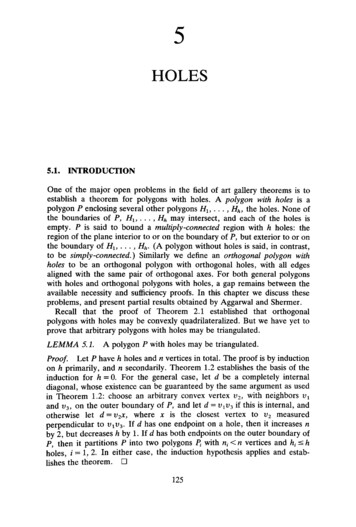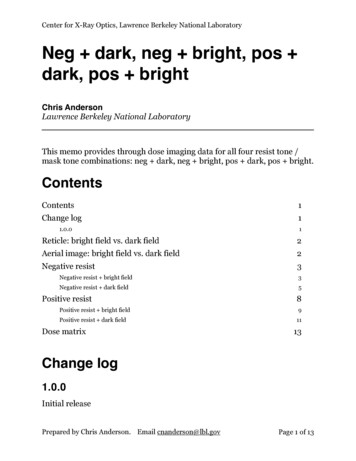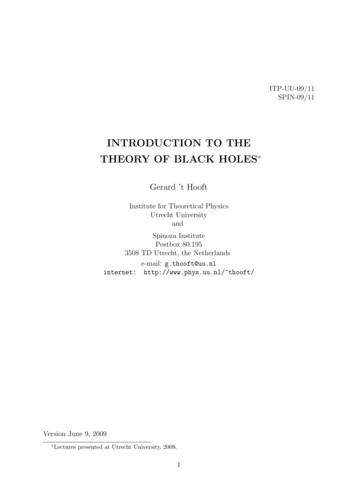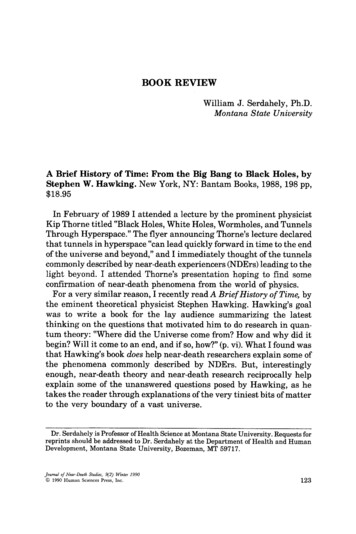
Transcription
HOLES5.1. INTRODUCTIONOne of the major open problems in the field of art gallery theorems is toestablish a theorem for polygons with holes. A polygon with holes is apolygon P enclosing several other polygons Hx, . . . , Hh, the holes. None ofthe boundaries of P, Hlf . . . , Hh may intersect, and each of the holes isempty. P is said to bound a multiply-connected region with h holes: theregion of the plane interior to or on the boundary of P, but exterior to or onthe boundary of Hx, . . . , Hh. (A polygon without holes is said, in contrast,to be simply-connected.) Similarly we define an orthogonal polygon withholes to be an orthogonal polygon with orthogonal holes, with all edgesaligned with the same pair of orthogonal axes. For both general polygonswith holes and orthogonal polygons with holes, a gap remains between theavailable necessity and sufficiency proofs. In this chapter we discuss theseproblems, and present partial results obtained by Aggarwal and Shermer.Recall that the proof of Theorem 2.1 established that orthogonalpolygons with holes may be convexly quadrilateralized. But we have yet toprove that arbitrary polygons with holes may be triangulated.LEMMA 5.1. A polygon P with holes may be triangulated.Proof. Let P have h holes and n vertices in total. The proof is by inductionon h primarily, and n secondarily. Theorem 1.2 establishes the basis of theinduction for h 0. For the general case, let d be a completely internaldiagonal, whose existence can be guaranteed by the same argument as usedin Theorem 1.2: choose an arbitrary convex vertex v2, with neighbors vxand v3, on the outer boundary of P, and let d vtv3 if this is internal, andotherwise let d v2x, where x is the closest vertex to v2 measuredperpendicular to f i 3 . If d has one endpoint on a hole, then it increases nby 2, but decreases h by 1. If d has both endpoints on the outer boundary ofP, then it partitions P into two polygons Pt with nt n vertices and ht hholes, i 1, 2. In either case, the induction hypothesis applies and establishes the theorem. 125
126HOLESThe number of triangles and quadrilaterals that result from triangulationand quadrilateralization are dependent on the number of holes:LEMMA 5.2. Let a polygon P with h holes have n vertices total, countingvertices on the holes as well as on the outer boundary. Then a triangulationof P has t n 2h - 2 triangles, and a quadrilateralization has q n/2 h — 1 quadrilaterals.Proof. Let the outer boundary of P have n0 vertices, and let the ith holehave n, vertices; thus n n0 n1 nh. The sum of the interior anglesof the outer boundary is (n0 - 2)180 degrees; the sum of the exterior anglesof the ith hole is (n{ 2)180. Thus180[(n0 2) («i 2) (nh 2)] 180rort n 2h-2.Since q t/2, q n/2 h-l.The same result may be obtained with Euler's Theorem. There are V nvertices, F t h 1 faces, one for each triangle and hole, plus theexterior face, and E (3t n)/2 edges, where three per triangle plus theboundary counts each edge twice. Then V — E F — 2 yields t n 2h—2as above. Throughout the remainder of the chapter, we will use n, h, t, and q todesignate the quantities defined in this lemma and P to represent a polygonwith holes (including the holes).The best sufficiency result for both the general and the orthogonalproblems is the following theorem.THEOREM 5.1 [O'Rourke 1982]. For a polygon of n vertices with hholes, [(« 2h)/3\ \t/3] combinatorial guards suffice to dominate anytriangulation, and for an orthogonal polygon, [(n 2h)/4\ \q/2]combinatorial guards suffice to dominate any quadrilateralization.Proof.1 First we note that the equivalences of \t/3] and [(n 2h)/3\, and\q/2\ and [(n 2h)/4\, follow directly from Lemma 5.2 by substitution.Thus this theorem is a direct extension of the sufficiency halves of Theorems1.1 and 2.2, which established respectively that [n/3\ \t/3] and [/i/4j \q/2] guards suffice.Given a polygon P with holes, triangulate it into t triangles; call thetriangulation T. The plan of the proof is to "cut" the polygon alongdiagonals of the triangulation in order to remove each hole by connecting itto the exterior of P. It is clear that every hole must have diagonals in T fromsome of its vertices to either other holes or the outer boundary of P. Cuttingalong any such diagonal either merges the hole with another, or connects itto the outside. In either case, each cut reduces the number of holes by one.We are not quite finished, however, because we need to choose the cuts sothat the result is a single polygon: it may be that a choice of cuts results inseveral disconnected pieces.1. I have incorporated several ideas from Aggarwal (1984).
5.2. GENERAL POLYGONS WITH HOLES127Fig. 5.1. A triangulation graph of a polygon with holes (a) and its dual (b): each hole in (a) issurrounded by a cycle in (b).Let t be the (non-weak) dual of the triangulation. T is a planar graph ofmaximum degree three, which, in its natural embedding, has h boundedfaces Flt . . . , Fh, one per hole of P. Let Fo be the exterior unbounded face.Choose any face Ft that shares at least one edge e with Fo. There must besuch a face because there must be a diagonal of T from the outer boundaryto some hole, and the dual of this diagonal in t, is e. Removal of e from tmerges Ft with Fo without disconnecting the graph. See Fig. 5.1 for anexample. Note that removal of an edge in f is equivalent to cutting P alongthe corresponding diagonal of T. Continuing to remove edges of t sharedwith the exterior face in this manner guarantees that a single connectedgraph results.Let P' be the polygon that results after all holes are cut in the abovemanner. Then P' has n 2h vertices, since two vertices are introduced percut, but because cuts do not create new triangles, it still has t triangles.Applying Theorem 1.1 to P' yields coverage by [(n 2h)/3\ \t/3]guards.The proof for orthogonal polygons is exactly the same, except thatTheorem 2.2 is invoked to obtain the result. Although this easily obtained theorem has a pleasing form whenexpressed in terms of t and q, it appears to be weak: no one has foundexamples of polygons that require this many guards. In fact, it is difficult tofind an example that requires more than [n/3\ guards independent of thenumber of holes. But we show in the next section that there are suchpolygons.5.2. GENERAL POLYGONS WITH HOLESSidarto discovered the one-hole polygon shown in Fig. 5.2a. It has n 8vertices, h 1 hole, and requires three guards. Note that 3 [8/3J.Shermer discovered the polygons in Figs. 5.2b and 5.2c, which also have
128HOLESabcFig. 5.2. One-hole polygons of 8 vertices that require 3 guards.eight vertices and require three guards. These one-hole examples can beextended to establish [(n l)/3j necessity for one hole: Figs. 5.3a and 5.3bshow two examples for n 11, due, respectively, to Shermer and Delcher.2Finally, the examples can be extended to more than one hole: Fig. 5.4shows Shermer's method of stitching together copies of the basic one-holeexample. The polygon shown has n 24 vertices, h 3 holes, and requiresnine guards. This example establishes [(n h)/3\ necessity for h holes. Wewill not attempt to prove that the claimed number of guards is necessary inthe examples just mentioned, as it should be obvious from the figures. Thefollowing theorem summarizes the implications of these examples.THEOREM 5.2 [Shermer 1982]. [(n h)/3\ guards are sometimes necessary for a polygon of n vertices and h holes.Note that Fig. 5.4 also establishes that [3«/8j guards are sometimesnecessary if we express the result solely as a function of n.The gap between the necessity of [(n h)/3\ and the sufficiency of[(n 2h)/3\ has proved very difficult to close. Since the gap widens as hincreases, it is not as insignificant as it might first appear. The strongestresult available is that [(n h)/3\ guards suffice for h 1, a theoremproved independently by Aggarwal and Shermer (Shermer 1984). We willfollow Shermer's proof technique here.abFig. 5.3. One-hole polygons of 11 vertices that require 4 guards.2. I assigned this as a homework problem in my computational geometry class. Julian Sidartoand Thomas Shermer, and Arthur Delcher, were students in that class in 1982 and 1985,respectively.
5.2. GENERAL POLYGONS WITH HOLES129Fig. 5.4. A polygon of 24 vertices with 3 holes that requires 9 guards.5.2.1.Reduced TriangulationsBefore outlining the proof, we first perform a reduction that eliminatesirrelevancies. The dual of a triangulation of a polygon with one hole has onecycle surrounding the hole, with (perhaps) several trees attached to thecycle. The next lemma shows that we can clip all the trees down to at mostone node. Define a reduced triangulation as one such that every subgraph ofthe triangulation dual G that may be disconnected from G by the removal ofa single arc, has exactly one node. Note that this definition is independentof the number of holes in the polygon from which the triangulation derives.We restrict the next lemma to one-hole polygons although it does extend tothe general case.LEMMA 5.3. If [(n l)/3j combinatorial guards suffice to dominateevery reduced triangulation of a polygon of n vertices and one hole, then[(n l)/3j guards suffice to dominate every triangulation of n vertices andone hole.Proof. The proof is by induction on the number of trees of more than onenode attached to cycles of the triangulation dual G. The basis is establishedby the antecedent of the lemma: [(n l)/3j guards suffice for a reducedtriangulation, which by definition has no attached trees of more than onenode. For the general step, assume [(n l)/3j guards suffice for anytriangulation with s' s trees of at least two nodes, and let G be anon-reduced triangulation with s such trees. Let T be one of these trees,detachable from G by the removal of one arc r. The situation is asillustrated in Fig. 5.5. Let a and b be the endpoints of the diagonal whosedual is r. Let m be the number of vertices in the polygon Q composed of thetriangles of T, not including a and b. We show that all but at most the root
130HOLESFig. 5.5. A tree T attached at diagonal ab to a cycle, which extends to the left and right.triangle of T can be covered "efficiently," that is, with one guard per threevertices. The proof proceeds in three cases, depending on the value ofm mod 3. The easiest cases are considered first.Case 0 (m 3k). The polygon Q has m 2 vertices, and it may thereforebe covered by [{m 2)/3j k guards by Theorem 1.1. Let P-Q be thepolygon remaining after removal of Q—that is, the deletion of all vertices inT except a and b, and all incident edges. Since P — Q has 5 - 1 attachedtrees of one node or more, the induction hypothesis guarantees coveragewith [(n — m l)/3j guards. Thus P may be covered with[(n - m 1)/3J k [[(n - m 1) m]/3j [(n l)/3j.guards.Case 2 (m 3k 2). The strategy used in Case 0 will lead to k 1 guardshere, which is insufficient for our purposes, so another approach must betaken. Augment Q to Q' by adding the triangle on the other side of ab,whose apex is JC. Q' is a polygon of m 3 3k 5 vertices and maytherefore be covered with [(3& 5)/3j k l guards by Theorem 1.1.Fisk's proof of that theorem (Section 1.2.1) assigns one vertex of triangleabx a guard. If JC is assigned a guard, it may be moved to a or b whilemaintaining complete coverage of Q'. Thus we may assume that a or b isassigned a guard. Suppose without loss of generality that a is assigned aguard. Let P' be the result of removing all of Q', all triangles incident on a,and splitting vertex x into two vertices. See Figs. 5.6a and 5.6b. P' hasn — m —1 1 vertices, since it is missing the m vertices of Q and vertex a,d0'abFig. 5.6. When 3k 2 vertices comprise T (a), the hole is removed by splitting x (b).
1315.2. GENERAL POLYGONS WITH HOLESabFig. 5.7. When 3k 1 vertices comprise T (a), one case is handled by covering R and abctogether, and L separately (b).but gains a vertex from the split of JC. Splitting x removes the hole, but P' isnot necessarily a polygon, as pieces may be attached at vertices only. Butnow connect each vertex of P' that was adjacent to a in P, to x. In Fig.5.6b, vertex d is so connected. These connections are not always geometrically possible, but for this case we are only concerned with the combinatorial structure of the graph. The reconnections do not increase thenumber of vertices, but they restore P' to be a triangulation graph of apolygon without holes. There is now no need to use the inductionhypothesis; rather apply Theorem 1.1 to P', resulting in coverage byL(n - m)/3j [[(n - 3(k 1)) l]/3j [(n l)/3j - (* 1)guards. Together with the k 1 guards used to cover Q', the lemma isestablished in this case.Case 1 (m 3k 1). Let the triangle forming the root of T be abc. Let /be the number of vertices in the left subtree L, not including a and c, andlet r be the number of vertices in the right subtree R, not including b and c.Thus m l r 1; see Fig. 5.7a. We consider two subcases dependent onthe values of / and r mod 3.Subcase la (I 3k1 and r 3k2; m 3{kx k2) 1). As in Case 0, cover Land R with kx and k2 guards. By the induction hypothesis, P — L-R can becovered withj [(n[[n - (/ r) 1]/3J [[[n - 3{kx k2) l]/3j{kx k2)guards, establishing the theorem. This is the only case in which T cannot beentirely removed, but is instead reduced to a single triangle abc.Subcase lb (I 3 1 and r 3k2 2; m 3{kx k2 1) 1). Let R' bethe polygon obtained by adding abc to R. R' has 3k2 5 vertices. Cover R'with k2 l guards by Theorem 1.1. Fisk's coloring procedure guaranteesthat one vertex of abc is assigned a guard. If either a or b (say a) is guarded,then proceed exactly as in Case 2: delete R' and a, and split x. Thecalculations are just as in Case 2, establishing the lemma. If on the otherhand c is guarded, then delete R' and all triangles of L incident on c, as in
132HOLESFig. 5.7b. This leaves at most / l 3 :1 2 vertices either disconnectedfrom P or attached at a. Addition of graph edges if necessary restores thispiece to a triangulation graph of a polygon L' without increasing thenumber of vertices. Cover U with k1 guards by Theorem 1.1. Now theremainder of P has n — m vertices and 5 — 1 attached trees. By the inductionhypothesis it may be covered withL(n - m 1)/3J [[n - 3(*t k2 1)]/3J [n/3\ - (k, k2 l)guards. Together with the k2 1 guards used to cover R', and the k1 guardsused for L', complete coverage has been achieved with fewer thanL(« l)/3j guards.All cases have now been covered, and the lemma established. The idea of reconnecting "broken" pieces into a polygon triangulationgraph is from Shermer (1985). Note that this technique was used only wheninduction was unnecessary, or was applied only to an attached tree. This iscrucial, as the geometry of the reduced triangulation is important in theproof of Theorem 5.3 below, and cannot be warped by curved reconnections that need to be straightened in the manner used in Lemma 3.1.5.2.2.Tough TriangulationsWe may now proceed with Shermer's proof of [(n l)/3j sufficiency for apolygon with one hole. The first step of the proof reveals why the problemis hard: there exist triangulations of polygons with h holes that require[(n 2h)/3\ combinatorial guards for domination. Thus the problemcannot be reduced to pure combinatorics by an arbitrary triangulation.Before proving this we introduce some notation.3 Lemma 5.3 permits us torestrict attention to reduced triangulations. Let T be a reduced triangulationof a polygon with one hole. Then T consists of a single cycle of triangles,each with perhaps one attached triangle that is not part of the cycle. A cycletriangle is based on the inner boundary if it has exactly one vertex, its apex,on the outer boundary of the polygon, and based on the outer boundary ifjust its apex is on the inner boundary. Note that the base edge of a cycletriangle based on the inner boundary may not itself be on the innerboundary because of a tree attached to the base; this is why the definition isphrased in terms of the apex. Label a cycle triangle " 1 " if it has no attachednon-cycle triangle, and "2" if it does. Then T is represented as a string ofcharacters over the alphabet {"1", "2", " / " } , formed by concatenating allthe labels of the cycle triangles, and inserting a "/" between labels Xx and A2if the kx triangle is based on the inner boundary and the A2 triangle is basedon the outer boundary, or vice versa. Thus each "/" records a switch inbasing. This string of characters will be called the string associated with T.Figure 5.8 shows an example. Starting at the indicated lowest triangle and3. The notation is due to Shermer (1984), but slightly modified here.
5.2. GENERAL POLYGONS WITH HOLES133tFig. 5.8. A triangulation of 10 vertices with string 121/121/1/1/ that requires 4 guards: the 3shown (dots) do not cover the shaded triangle.proceeding counterclockwise, we obtain the string 121/121/1/1/. Note thatthe sum of the integers in the string is equal to the total number of trianglesin T, and because t n when h - 1 by Lemma 5.2, this is the same as thenumber of vertices of the polygon. We will employ standard regularexpression notation to condense the strings: " " for "or," sk for krepetitions of string s, and s* for zero or more repetitions of s. Thus theabove string is equivalent to (121/)2(1/)2 and is an instance of (1(21) */) 4 .We consider two strings equivalent if one is a cyclic shift of the other, or acyclic shift of the reverse of another. Finally note that the strings make nodistinction between the inner and outer boundaries, and in fact thisdistinction is irrelevant for combinatorial guards.A complete characterization of those triangulations that require[(« 2h)/3\ combinatorial guards for h 1 is provided by the followingtheorem (Shermer 1984).THEOREM 5.3 [Shermer 1984]. A reduced triangulation T of a polygonwith one hole requires [(n 2)/3j combinatorial guards for completedomination iff the string for Thas the form (l(21)*/)6* 2.We will call a string that is an instance of (l(21)*/)6fc 2 tough. Figure 5.8satisfies the theorem: n 10 and it requires [12/3J 4 combinatorialguards; an attempted cover with three guards is shown in the figure. Figure5.9 shows a polygon with the string (121/)10; here n 40 and [42/3J 14guards are required. Even triangulations whose strings are tough but do notcorrespond to any non-degenerate polygon require [(n 2)/3jcombinatorial guards. Figure 5.10 shows the smallest possible instance,(I/) 4 , where n 4 and g [6/2J 2. Figure 5.8 is the smallest instancerealizable as a polygon. All these examples are from Shermer (1984).Proof of Theorem 5.3. We first prove that a triangulation graph T with atough string requires [(n 2)/3j combinatorial guards. The proof is byinduction, in two parts. First it is shown that the claim holds for strings of
134HOLESFig. 5.9. A triangulation of 40 vertices with string (121/)shown (dots) do not cover the shaded triangle.that requires 14 guards: the 13the form (l/)6k 2. Then it is shown that each addition of a (21) sectionrequires another guard.Triangulations of the form (l/)6k 2 have a particularly simple structure,illustrated for k 2 in Fig. 5.11. Each vertex is adjacent to exactly threetriangles. Thus g \t/3] guards are necessary. But since t n — 6k — 2,g [(6A; - 2)/3] 2k [(n 2)/3j, establishing the first claim.Now assume that all triangulations T of n vertices with tough stringsrequire g [(n 2)/3j guards, and consider adding three vertices to such aT by insertion of a (21) section 5 after a " 1 " triangle and before a "/"switch. Clearly any triangulation of n 3 vertices that is an instance of thetough form (1(21)*/)6k 2 can be obtained by such an insertion. Assume, incontradiction to our goal, that the insertion does not increase the number ofguards required beyond g. We claim then that T could have been coveredby g - 1 guards. S must be covered in one of the three ways illustrated inFigs. 5.12a, 5.12b, or 5.12c. If S is covered as in Fig. 5.12a, then removal ofthe section and the guard results in domination of T by g — 1 guards. If S iscovered as in Fig. 5.12b, then deleting S merges two guards, again resultingin coverage by g — 1 guards. Finally, if S is covered as in Fig. 5.12c, thenremoval of S leaves two guards, one of which (the bottom one in the figure)is superfluous because every triangle to which it is adjacent is alreadycovered. So again T can be dominated by g — 1 guards. This contradicts theassumption that g are necessary, establishing that the form (l(21)*/)6fc 2always requires [(n 2)/3j combinatorial guards.Fig. 5.10. A triangulation of 4 vertices with string (I/) 4 that requires 2 guards: the 1 shown(dot) does not cover the shaded triangle.
5.2. GENERAL POLYGONS WITH HOLES135Fig. 5.11. A triangulation of 10 vertices with string (I/) 10 that requires 4 guards: the 3 shown(dots) do not cover the shaded triangle.Now we prove the theorem in the other direction, in the contrapositiveform: if a triangulation T does not have a tough string, then fewer than[(n 2)/3j combinatorial guards suffice for domination. Each 1 in a toughstring must be followed by (2 1), and each 2 by 1. Thus, any non-toughtriangulation must contain a fragment of the form 11, 22, or 2/. Each ofthese cases is treated separately.abcFig. 5.12. Three ways to guard a (21) section.Case 1 (11). Let ab be the diagonal shared between the two " 1 " triangles,with b an apex of both, as shown in Fig. 5.13a. Place a guard at b, delete allcovered triangles, and add in extra edges as needed to restore to a polygonwith no holes, as shown in Fig. 5.13b. The result is a triangulation of apolygon of no more than n — 2 vertices, and so T may be dominated with1 L(n - 2)/3j [(n 1)/3J guards.Case 2 (22). Again let ab be the shared diagonal, with a incident to all fourtriangles, as shown in Fig. 5.14a. Place a guard at a, delete the four adjacenttriangles, and split node b into two nodes, as shown in Fig. 5.14b. The resultis a polygon of n - 2 vertices, so again T can be dominated withl [ ( n - 2)/3j L(» 1)/3J guards.aFig. 5.13.bGuarding a l l fragment (a) removes the hole (b).
136HOLESaFig. 5.14.bGuarding a 22 fragment (a) removes the hole after splitting a vertex (b).Case 3 ill). Here we must consider several subcases, depending on thetriangles adjacent to the 2/ fragment.Case 3a (2/1). See Fig. 5.15a. Place a guard at a and delete adjacenttriangles. The result is a polygon of n - 2 vertices, and we proceed as inCase 1.Case 3b (2/2). Again we consider subcases.Subcase (2/21). See Fig. 5.15b. Place a guard at a as in Case 3a.Subcase (2/22). This was already handled in Case 2.Subcase (2/2/1). This was already handled in Case 3a.Subcase (2/2/2). See Fig. 5.15c. Place a guard at a, delete all adjacenttriangles, and split vertex b. Now proceed as in Case 2.abcFig. 5.15. The three cases for the fragment 2/ are all handled by guarding vertex a.We have thus shown that [(n l)/3j combinatorial guards suffice wheneverone of the fragments 11, 22, or 2/ are present in T"s string, establishing thetheorem. 5.2.3.Convex Pairs and TripletsThe second step of Shermer's proof of Theorem 5.3 is to furthercharacterize those one-hole polygon triangulations that might require[(« 2)/3j guards, this time involving the geometry of the triangulationand using geometric guards. In particular, if a tough triangulation containseither a "c-pair" or a "c-triplet," then [(n l)/3j guards suffice. The thirdand final step is to show that every tough triangulation must contain one ofthese two structures.A c-pair is a pair of adjacent cycle triangles that together form a convexquadrilateral.
5.2. GENERAL POLYGONS WITH HOLESa137bFig. 5.16. Flipping a 1/1 c-pair leads to 11/1 (a) or 2/1/1 (b).LEMMA 5.4. A polygon with a tough triangulation containing a c-pairmay be covered with [(n l)/3j vertex guards.Proof. The strategy is to flip the diagonal of the c-pair, changing thestructure of the triangulation to non-tough. Since the triangulation has thestring (1(21)*l)6k 2, the c-pair has either the form 1/1 or 21 (or equivalently12). Each case is considered separately.Case 1 (1/1). Flip the diagonal of the c-pair. Since the quadrilateral isconvex, this is possible. The resulting triangulation is not tough, as can beseen in Fig. 5.16. If the triangle preceding the c-pair is of type 1, then thefragment 1/(1/1) is changed to 11/1 (Fig. 5.16a). If the preceding triangle isof type 2, then the fragment 2(1/1) is changed to 2/1/1. Neither of thesenew fragments are substrings of any tough string. By Theorem 5.3, then,[(« l)/3j guards suffice.Case 2 (21). Again flip the diagonal. The resulting triangulation, shown inFig. 5.17, is not reduced. But this is just Case 2 of the proof of Lemma 5.3.Place a guard at a, delete all adjacent triangles, split vertex c in two, andrestore to a polygon triangulation by adding diagonals as necessary. Threevertices are deleted, and one added. Since the result is a polygon, coverageby 1 [(« - 2)/2j [(« l)/3j guards has been achieved. Fig. 5.17. Flipping a 21 c-pair leads to the case considered in Fig. 5.6.A c-triplet is a triple {A, B, C) of consecutive cycle triangles such thatfirst, B is of string type 1, and second, the union of the three triangles maybe partitioned into two convex pieces.LEMMA 5.5. A polygon with a tough triangulation containing a c-tripletmay be covered with [(« l)/3j vertex guards.Proof. Let a be the vertex common to the c-triplet triangles A, B, and C,as shown in Fig. 5.18a. Delete B and split vertex a. The result is a polygonof no holes with n 1 vertices, which may therefore be covered with[(n l)/3j vertex guards by Theorem 1.1. In particular, perform the
138HOLESabFig. 5.18. A c-triplet is covered if A and C are covered (a), but B is not covered if thetriangles do not form a c-triplet.coverage with Fisk's coloring procedure; then both A and C must have aguard in one of their corners. Now put back B. Because the three trianglesform a c-triplet, B is also covered by the guards covering A and C. Note that if the triangles did not form a c-triplet, as in Fig. 5.18b, Bwould not necessarily be covered. Similarly, if B were of string type 2, thetriangle attached to B would not necessarily be covered.We finally come to the last step of the proof. For a triangle tt, define theopen cone delimited by the two edges of tt passing through the apex as x(i),and define the similar region off the right base vertex as /3(z); see Fig. 5.19.LEMMA 5.6. Any tough triangulation of a polygon contains either ac-pair or a c-triplet.Proof. The proof is by contradiction. Assume a tough triangulationcontains no c-pair or c-triplet. Then we will show that it cannot close into acycle, and so is not the triangulation of a polygon with one hole.Identify two adjacent cycle triangles of the form 1/1; such a fragmentmust exist because the general form is (1(21) */) 6 " 2 . We will identifytriangles by subscripts on their type. The selected 1/1 fragment is labeledlo/li- We expand this string to the right in all possible ways compatible withthe general tough form, and show that a particular geometric structurealways results. Let a string S end at the right with 1,, and let vt be the vertexat the tip of the ear lt. Then define an embedding of S to be nesting if vt isFig. 5.19. The apex cone a and base cone j3 for a triangle.
5.2. GENERAL POLYGONS WITH HOLESFig. 5.20.139lo/li is nesting.in the base cone /3(i -1) of the triangle adjacent to 1,. We now show thatl o /li is nesting.The general form of this fragment is as shown in Fig. 5.20a. In order toavoid a c-pair, either the configuration shown in Fig. 5.20b or 5.20c musthold. In Fig. 5.20b, vl e /S(0), and so the nesting definition is satisfied.Figure 5.20c is just Fig. 5.20b reflected in a horizontal line, and we assumewithout loss of generality that 5.20b obtains.The string l o /li may be extended only with /I or 21 while remainingcompatible with the tough form. We consider each case separately.Case 1 (l o /li/l 2 )- The general form is shown in Fig. 5.21a. In order toavoid a c-pair in li/l 2 , either v2 e ar(l) or v2 e j3(l). The former choice (Fig.5.21b) leads to a c-triplet, and the latter choice (Fig. 5.21c) is a nestingconfiguration.Fig. 5.21. l o / l i / l 2 is nesting.Case 2 (l o /li/2 2 l 3 ). As in Case 1, we must have v2e/3(l). To avoid ac-pair in 2213, we must have v3 e fi(2), as illustrated in Fig. 5.22. Again theconfiguration is nesting.Fig. 5.22.is nesting.
140HOLESVVniS(i-i)Fig. 5.23. Repeated nesting prevents vn from coinciding with v0.Both Case 1 and 2 may be extended only with /I or with 21. Extension ofCase 1 results in the same two cases again, although the possibility thatv3 e ar(2) is blocked by l 0 , so this choice does not have to be ruled out byshowing that it leads to a c-triple. Similarly extension of Case 2 brings usback to the same two cases. We conclude that every embedding of the stringcompatible with the tough form is nesting.But now the contradiction is immediate. The repeated nesting forcesvt e fi(i — 1), and since these base cones are clearly nested inside oneanother (see Fig. 5.23), the embedding cannot wrap back around to permitvn v0.OTHEOREM 5.4 [Aggarwal, Shermer 1984]. [(n l)/3j vertex guardssuffice to cover any n vertex polygon with one hole.Proof. Lemma 5.3 established that if the theorem holds for reducedtriangulations, then it holds for all triangulations. So we restrict ourattention to reduced triangulations. Theorem 5.3 shows that if the reducedtriangulation is not tough, then [(n l)/3j vertex guards suffice. So weneed only cons
HOLES 5.1. INTRODUCTION One of the major open problems in the field of art gallery theorems is to establish a theorem for polygons with holes. A polygon with holes is a










